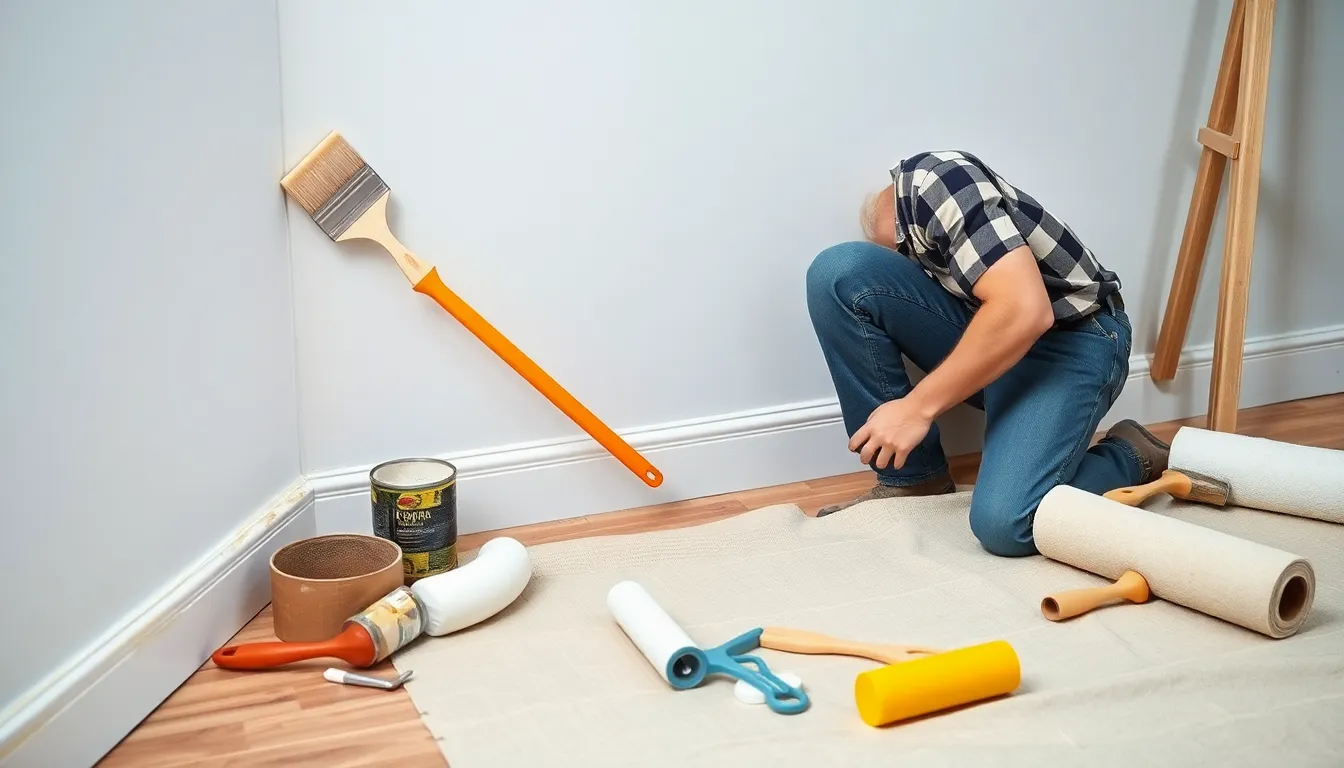When it comes to home improvement, painting trim might not be the first thing that pops into mind. Yet, it’s the unsung hero of any room, transforming ordinary walls into extraordinary spaces. Think of trim as the icing on the cake—without it, everything just looks a little flat. So why settle for drab when you can have fab?
Table of Contents
ToggleOverview of Painting Trim Techniques
Painting trim requires specific techniques to achieve a professional finish. Numerous methods exist for application. The right technique often depends on the trim material and the desired look.
Brush technique delivers precision for detailed areas, allowing for smooth edges and crisp lines. Paint with a high-quality angled brush, keeping the bristles only partially loaded to prevent drips.
Roller application covers larger surfaces efficiently. Choosing a mini roller provides a smooth texture that complements the trim’s design. Use a small nap for best results.
Spraying is a favored approach for achieving an even coat. It works well on intricate profiles and can significantly reduce application time. Ensure proper ventilation and use a spray mask for protection.
Staining offers an alternative for those wanting to highlight natural wood grain. A foam brush can be ideal for applying the stain evenly. Test a small area first to confirm the desired color.
Prep work plays a crucial role in any painting technique. Clean the trim surface thoroughly to remove dust and grease. Sanding may be necessary to create a smooth base.
Taping ensures clean lines between the trim and adjacent surfaces. Use painter’s tape to prevent paint from bleeding onto walls or ceilings. Remove the tape while the paint is still wet for the best result.
Finally, selecting the right paint finish matters. Satin or semi-gloss is often recommended for trim, providing durability and enhancing detail. Review product specifications before making a choice.
Tools and Materials Needed

Proper tools and materials enhance the painting trim process, ensuring quality and efficiency.
Brushes and Rollers
Selecting the right brushes and rollers significantly impacts the finished look. Angled brushes excel at reaching corners and edges, providing precision on detailed areas. For larger trim surfaces, a high-density roller covers more area, promoting an even finish. Foam rollers work well for smooth surfaces, helping eliminate texture and streaks. Synthetic brushes are ideal for water-based paints, while natural bristle brushes suit oil-based options. Both choices should maintain quality for optimal results. Keeping brushes clean during the painting process prevents paint hardening, maintains their shape, and prolongs their usability.
Tape and Drop Cloths
Utilizing painter’s tape and drop cloths minimizes mess and ensures clean lines. Painter’s tape adheres well to various surfaces, creating sharp edges without pulling off paint. It’s essential to apply the tape carefully to avoid gaps that allow paint bleed. Drop cloths protect floors and furniture from spills and drips. Canvas drop cloths are durable and reusable, while plastic alternatives are lightweight and ideal for quick projects. Covering the surrounding areas allows for a focused painting experience. Choosing the right materials fosters a smoother and more enjoyable painting process.
Preparing the Trim for Painting
Preparing trim for painting involves crucial steps that ensure a smooth application and a high-quality finish. The process starts with cleaning and sanding.
Cleaning and Sanding
Cleaning trim removes dust, grease, and old paint remnants. Use a damp cloth or sponge with mild detergent to wipe surfaces thoroughly. Allow the trim to dry completely before proceeding. Sanding smooths the surface for better paint adherence. Choose a fine-grit sandpaper, such as 220-grit, to avoid deep scratches. Focus on edges and detailed areas, being careful to remove any rough spots. After sanding, clean the trim again to eliminate sanding dust, ensuring a pristine work surface for painting.
Priming the Surface
Priming surfaces enhances paint durability and prevents stains from bleeding through. Select a high-quality primer suited for the trim material, whether it’s wood or MDF. Apply the primer using a brush or roller, paying attention to crevices and corners. A second coat may be necessary for optimal coverage. Let the primer dry according to the manufacturer’s instructions before moving to the painting phase. Properly primed surfaces allow for an even topcoat, resulting in a professional finish that lasts.
Popular Painting Trim Techniques
Various techniques exist for achieving professional results when painting trim. Each method offers unique advantages depending on the project’s requirements.
Brush Painting
Brush painting provides precision, especially for detailed areas like corners and intricate designs. Using an angled brush enhances control, ensuring clean lines around edges. For best results, choose a high-quality brush made from synthetic bristles, as this encourages smooth application of paint. Starting with a thin coat allows optimal adherence to the trim surface, leading to improved durability. Allowing each layer to dry completely before applying additional coats achieves an even finish without streaks.
Spray Painting
Spray painting delivers a smooth, even finish, making it ideal for larger trim areas or complex profiles. Using a paint sprayer requires proper technique to avoid overspray and ensure consistent coverage. One key tip involves maintaining a steady distance of 12 to 16 inches from the surface, which prevents dripping. Wearing protective gear during this process provides safety against paint mist. Thoroughly prepping the area beforehand, including taping off surfaces and using drop cloths, minimizes mess and maximizes efficiency.
Roller Application
Roller application suits larger flat areas of trim, significantly speeding up the painting process. Selecting a high-density roller covers surfaces evenly, which is essential for achieving a professional look. Opting for foam rollers offers a smooth finish on flat trim, eliminating texture and minimizing streaks. Applying paint in thin coats allows for better drying and prevents dripping. Along the way, using a brush to touch up corners or edges ensures perfect lines, blending seamlessly with the rolled areas.
Tips for Achieving a Professional Finish
Selecting the right paint significantly impacts the final look of trim. Satin or semi-gloss finishes are ideal choices due to their durability and ability to reflect light. These finishes highlight detail while making cleanup easier. When choosing paint, consider the trim’s material—wood requires different formulations than composite materials. Always opt for high-quality paints designed specifically for trim work. Reading reviews and consulting experts can help in determining the best options.
Understanding layering and drying times helps achieve a flawless finish. Aiming for thin layers promotes even coverage and faster drying. It’s best to wait for the paint to dry completely before applying additional coats—this prevents peeling and ensures adhesion. Refer to the manufacturer’s instructions for specific drying times. Typically, waiting at least two to four hours between coats yields optimal results. Being patient during this process leads to a more professional appearance in the final product.
Painting trim can transform a space and elevate its overall appeal. With the right techniques and tools, anyone can achieve a professional finish that enhances the beauty of their home. Careful preparation and attention to detail are key to ensuring a smooth application and long-lasting results.
By selecting the appropriate paint and employing effective methods like brush painting, roller application, or spray techniques, the trim can become a standout feature. Whether it’s a fresh coat of paint or a stunning stain, the right choice can make all the difference. Investing time and effort into this often-overlooked aspect of home decor pays off in creating inviting and vibrant spaces.



